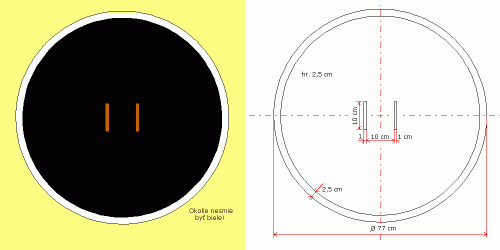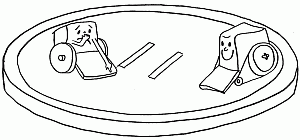
This is an unofficial translation of the rules. The only official version of the rules in cases of misunderstanding is the Slovak version.
LegoSumo category rules
Introduction
Two self-controlled robots are placed in a ring. The robots try to avoid falling out or avoid being pushed out by the opponent robot. The first robot that touches outside of the ring loses the round. Different robots compete one-on-one against each other throughout the contest. The robot that wins the most matches wins the contest.
The Ring
The Robot Sumo ring is a flat disc where robots are to compete.
The top surface is dull black, except for a thin border that is shiny white. Two starting lines in the middle are brown. The ring surface should be as flat as possible to not influence robots movement.
The dimensions of the ring are on the following picture and table:
| Diameter | Height | Width of the white margin | Width of the start line | Length of the start line | Distance of the start line from the center |
| 77 cm | 2,5 cm | 2,5 cm | 1 cm | 10 cm | 5 cm |
An external area of at least 100 centimeters (3.3 feet) of empty space exists around the ring. This space must not contain any people, objects, lights, or anything else that would distract or interfere with the robots. The floor may be any color but white.
Robots
In this category, only Lego robots are allowed. No other components (except the lead weights for increasing the weight to the maximum allowed).Mass and Dimensions

Mini-class Sumo robots may have a mass of 1000 grams or less.
Lift can't reduce the robot below the required limit because the limit is specified in mass (universal constant) rather than weight (gravity component). For example, a helium-filled balloon can't be used to lighten a robot during weigh in.
Because this is a pushing contest, it is to the robot's advantage to be as heavy as possible. Please note, that your kitchen scale may be different from the contest one. Many builders bring extra weights or washers to modify (increase) the robot's mass to the maximum amount as measured at the contest location. Be carefull when replacing the batteries, their mass may vary.
Dimensions
At the start of each round, Sumo robots must not exceed a specified width and depth. Mini-class Sumo robots may be 15 centimeters or less in width and 15 centimeters or less in depth. There is no height limit.
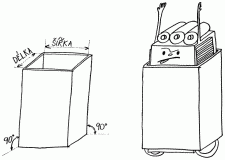
Also, as soon as movement is allowed in a round, the robot may then twist, fall, or expand without size limits.
The lack of a height limit is important to some builders, as they may stack up electronics, motors, and other parts that wouldn't otherwise fit. The lack of a height limit combined with the ability to change orientation during a round provides for creative opportunities. Crafty inventors build tall scoops atop their robots. The robots then fall down to make themselves longer than would be initially allowed.

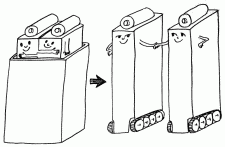
The competition and the order of the competitors
The competition can take several forms depending on the number of robots registered. The rules assume one-to-one matches. This method will best ensure that the best robot actually wins.
The order of competitors will be drawn just before the competition. Participants must complete the competition in the order determined by the draw.
Inspection
Before each start, the jury must carry out a compulsory inspection, during which mainly the dimensions and weight are checked. This is to ensure that changes made between matches do not violate the basic rules of the competition.
The judges will carry out the inspection as follows: before each match, they will first weigh the robot. Then the starter puts it on the starting position. From this moment on, throughout the whole measurement, nobody may touch it, hold it, etc. The judge will check that in this position it is possible to pull a profile with internal dimensions of 15 x 15 cm over the robot. The profile must touch the ring with its entire perpendicular section. The measurement must therefore be perpendicular to the ring. If the robot passes through the profile, it is possible to continue competing with it. If it does not, the judge will call on the competitor to correct it. The correction must not take more than 2 minutes. There may be a maximum of two corrections. Otherwise, the match is considered lost.
A weight check shall be made before each match. A check of positioning and dimensions shall be made before each bout.
The time between attempts can be used by the participant for any corrections and adjustments. However, if he/she does not arrive within 1 minute after the call to start, he/she loses the right to take part in the duel. In the event of a large number of entries, the jury may reduce the number of bouts or declare a qualifying round.
Playoffs
Depending on how many robots participate, the organizers can choose a number of different elimination methodologies.
A Match
Individual competitors are invited to wrestle in a manner appropriate to the conditions. It is announced who (competitor), with which robot (number and name) and to which ring (ring number if more than one is used in the competition). Within one minute, the competitor is required to report to the ring in which he/she will compete.The match consists of three duels. Each duel lasts a maximum of three minutes.
Positioning
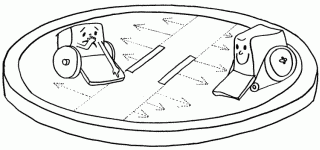
In the first match of the match, a coin toss is used to decide which competitor places their robot in the ring first. In subsequent duels, the winner of the previous duel places the robot. If there was a tie, the coin decides.
The robot must be placed on its part of the ring, i.e. no part of it may extend beyond the extended starting line.
In this part of itself, it may be rotated at will to accommodate the inspection.
Pre-start inspection
Next, a pre-start inspection shall be carried out.
After the inspection, the competitors bow to each other before the match as a sign of respect for their opponent.
Activation
On the timer's instruction, both starters switch on their robot. The robot can be activated by means other than pressing the switch.For this purpose it is allowed to use a sound, light, radio or other signal (clap, whistle...). The controller may not be used later in the fight. The robot must be programmed to start its activity only after 5 seconds have elapsed, during which time all persons must move away from the ring beyond the active zone.
In the first five seconds, only acoustic and luminous displays of the robots are possible (buzzers, countdown...), but not motion activities. It should be stressed that the choice of how to activate the robot is at your own risk, and applause or photography of the robot by the audience may inadvertently activate the robot in these cases. It is therefore advisable to consider the activation method carefully. Activation can only be performed in one initiating action. It is not permissible to change, for example, the configuration of the robot within the activation by several actions. However, it is permissible to have several "initiation switches" on the robot, the selection of which determines the strategy. In any case, however, the "single-action" principle must be followed.
If, during the countdown, the starter finds that his robot is not working or the robot starts early, he can signal to the judge. The latter will stop the countdown. The duel is immediately repeated. If this happens a second time, the contestant is disqualified from the contest and loses points to the opponent. Intentionally programming a countdown interval shorter than five seconds will result in disqualification for the entire competition.
Finishing
A robot is considered to be eliminated if any part of it (including, for example, a part that has fallen off during the match) touches a surface outside the ring. The edge of the ring does not count as an area outside the ring. The rim of the ring already counts as an area outside the ring.

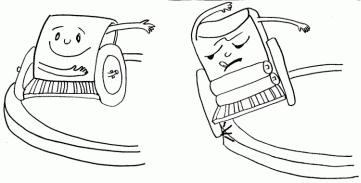
If neither of the competing robots is eliminated, the match is terminated by the jury after three minutes.
If a competitor tries to influence the duel in any way during the duel or during the countdown (entering the active zone, using the remote control, etc.), he is disqualified.
Time limits
There must be at least a five-minute break between each match of the same robot for servicing (changing batteries...). The purpose of this is so that the order of matches does not favor some robots.
Evaluation and results
The winning robot receives 2 points, the loser 0 points. If no one wins within three minutes, it's a tie. 1 point is awarded for a tie.
At the end, the number of points is added up and a ranking is formed. If some competitors have the same number of points, the ranking between them is decided by the matches between them. If the mutual matches end in a tie, the competitors will share the ranking (multiple robots in the same place).
The robot with the highest number of points will be the winner. Each robot entered in the matches will receive a diploma.
In addition, the jury may award a prize for the best design and the most elegant design.
Disqualification
In general, any violation of the rules will disqualify the robot from the competition. This is especially true in the following situations:
- unsafe behaviour, safety hazards,
- damage of the ring,
- if a competitor touches the robot during a fight.
The robot may be disqualified from the whole competition, from the match or from a duel. If disqualified from a competition, it is not scored at all and is viewed as if it did not participate in the competition at all. If he is disqualified from a match, 6 points will be added to the opponent and 0 to the disqualified. If he is disqualified from a duel, 2 points are awarded to the opponent and 0 to the disqualified.
A contestant is disqualified from the contest only for a serious violation of the contest conditions, e.g. cheating.
A competitor is disqualified from a match if, after the match has already been completed, he is found to have violated the terms of the competition in that match.
Disqualification from a duel if a violation of the conditions of competition is found during or immediately after the duel has just ended and if the violation is related only to the specific duel.
A robot can only be disqualified by the jury.
Safety restrictions
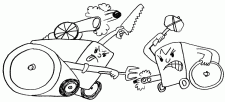 The Jury will only admit a robot to a match that is not expected to cause significant and dangerous harm to its surroundings. For one that is not likely
to be able to "survive" jostling, bumping, tipping and other manipulations within the rules of the competition, the jury members are required to warn
the competitors of the potential risk. Competitors start at their own risk, and the possible "breaking down" of a robot during the course of a competition
is not grounds for disqualification of an opponent.
The Jury will only admit a robot to a match that is not expected to cause significant and dangerous harm to its surroundings. For one that is not likely
to be able to "survive" jostling, bumping, tipping and other manipulations within the rules of the competition, the jury members are required to warn
the competitors of the potential risk. Competitors start at their own risk, and the possible "breaking down" of a robot during the course of a competition
is not grounds for disqualification of an opponent.
The competition means used by the robots must not be aggressive, destructive. The strategy must not result in damage to the opponent's robot and equipment (e.g. ring). This basic principle applies even if it is unintentional on the part of the robot creator (the robot itself goes "crazy" and starts acting dangerously and destructively to itself or its surroundings). No destructive means such as those known from the "Robot Wars" sets (flamethrowers, electric discharges, various saws or hammers...) may be used.
 The robot must not discharge any substances such as oils or acids, must not emit smoke or fire, must not pollute the ring or the opponent's robot, must
not use any sprays.
The robot must not discharge any substances such as oils or acids, must not emit smoke or fire, must not pollute the ring or the opponent's robot, must
not use any sprays.
The robot must not throw or shoot anything. No ropes or nets may be used to prevent movement of the opponent. The robot must not fly, i.e. at least one part of the robot must be in contact with the ring at all times. However, the rules allow the use of flying parts of the robot (e.g. navigation aids, cameras, etc.). But the basic principle is that the opponent must be able to push the opponent out of the ring at any time.
Adhesion
Means to increase adhesion (grip to the ring surface) must comply with the following standard rule for assessing the robot's adhesion capability: a robot is considered capable if, after being placed on a sheet of paper and then lifted up, the paper remains lying on the pad when adhesion-enhancing technologies are activated.
And, of course, all the common rules apply.
These rules are mainly a translation of the rules published by Josef Szylar on robozor.cz.
In addition, we are mainly based on the detailed rules on David Cook's website.
We would like to thank Michaela Szylar for the pictures.
